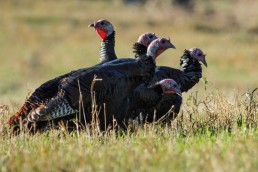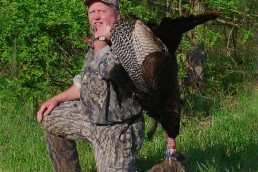It’s Almost Turkey Time!
SHARE THIS POST
Spring turkey hunting tips
I can recall that my facemask was soaked in sweat as I ascended the huge Wisconsin ridge. I was trying to make it to the top to intercept a gobbler that had been answering my calls, and I had only thirty minutes of legal shooting time left. When I found what I thought was a good spot to set up, it sounded like he was within 150 yards. He was fired-up and I thought this was going to be a “slam-dunk.”
Do you know the success rate of most hunters? It’s hard for me to believe, but it’s only around 12 to 14 percent for a turkey hunter, regardless of method! I guess that’s difficult for me to fathom because that’s not a “daily rate,” that’s for the entire season! I’m stating this for the purpose of this point, not to “crow,” but I can’t remember the last hunting season when I didn’t have success. I know some of you are right there with me. Why? I ensure success though scouting and preparation.
Something you missed
During the next twenty-five minutes, I brought the tom within fifty to sixty yards three different times only to have him strut there for a minute and turn away. With legal hunting hours over for the day I let the big tom walk off. I was curious to know why that stupid bird with a brain the size of a walnut wouldn’t come closer. Come to find out, I was the dim-witted one. I hadn’t noticed an old fence-line that had grown into the landscape. The gobbler didn’t want to cross the fence, no matter how sweet I sounded on the call.
Scouting is possibly the biggest element of hunting anything, but it’s especially important when pursuing turkeys. Learning their roost locations, strutting zones, grit sources, available water and the lay of the land is of utmost importance. I have called gobblers through fences and over creeks before, but don’t count on it happening often.
Know where to nail ‘em
Learning where the birds will be at certain times of the day will pay off in spades. Keep a journal if necessary. If you get them to answer your calls, write down the time, place and which call he answered to. If you “take their temperature” while scouting, it can make it seem easy when it’s time to hunt.
After the tom is finished with his hens for the day, many times they go day after day to preferred strutting locations. Make note of these spots, and the different avenues they use to access them. Keep records of wherever and whenever you see a bird. Turkeys are creatures of habit and will often have the same daily patterns day after day.
Recent information is important. It depends upon the sun, species and habitat conditions, but turkeys can make huge moves and deviations in their yearly patterns. From day to day they can be more predictable. So, don’t count on a gobbler being where you saw it three months ago, but there’s a good chance he’ll be in the same area where you saw him a few days ago.
You need to choose a location that offers the birds’ easy access. Don’t set up across a river, fence, drainage or bunch of blow-downs and expect to call gobblers to you. You have to make it simple for them to get to you.
Are you enjoying this post?
You can be among the first to get the latest info on where to go, what to use and how to use it!
Putting the call out
Getting an answer to a locator call is one of the most popular ways of discovering a gobbler’s location. However, you may have to be well versed on a number of calls, especially if you hunt different areas. For instance, in the pine-ridge area of South Dakota, I’ve found a coyote howl or peacock call works great. When using the same call while hunting northern Missouri, they seem to be pretty “tight-lipped” to it. There, they appear to answer better to an owl hoot during mornings and evenings, and a crow call during daylight. In most areas, a simple hoot or crow call will work great.
If you run up against a bird that some label as “call shy,” you can sometimes howl, caw and hoot yourself blue in the face and get nothing to acknowledge you. In this case, “hen-talk” may be the only way to get them to answer. You would use the same calls you would while hunting.
In all honesty, I don’t believe turkeys get “call shy” I think they get “hunter-shy.” Hunters educate the birds by making mistakes. The last time the bird responded to those sounds, he ran into a camo-clad dude sitting at the base of a tree. Or, worse yet, a non-lethal load of #6 shot. They no longer react positively to the sound.
Over-calling gone wrong
With that said, let me caution you on going overboard with hen sounds during pre-season. Educating the bird can make it tough when you need to score once opening day comes around. I do not suggest using hen talk often during pre-season. When you’re not actually hunting the bird, get him to answer once or twice and then leave well enough alone. I’ve got a buddy that likes to go out and practice, sometimes calling in the same bird two or three times before the season starts. If you’re good, that may work great. You can learn what each individual bird “turns on” to. Then again, it only takes one mistake to educate a gobbler to avoid you when the season rolls around.
Optics of the situation
Quality optics are a very important part of both turkey hunting and turkey scouting. When up against the uncanny eyesight of a turkey, it’s nice to be able to “even the odds.” Optics are especially important when bad weather causes the birds to be “tight-lipped.”
Scout as you hunt. Pay attention to details while you’re hunting, even if it’s not immediately important. Remember where you heard other gobbles, where you saw other toms and the time of day when each happened. If your target bird fails to cooperate, then you have other options.
Pending when you are scouting, remember that the toms might be doing something a bit different when hunting time rolls around. As said above, if you’re scouting a month or two before the season, the birds will probably have a different daily routine and possibly even inhabit a bit different area when the season is at hand. This time of the year, they are coming out of their winter patterns and most likely will break up into smaller groups that will possibly move to different locations within their home range. The most reliable information will be gathered within a week before you actually hunt.
Scouting is an important part of hunting anything. It’s fun, builds confidence and helps so you’re not stumbling around on opening day. It’s also a great way to introduce new hunters to the woods. Scouting is a critical part of the hunt and will help you to fill your tag this season.
MWO
SHARE THIS POST
Did you enjoy this post?
You can be among the first to get the latest info on where to go, what to use and how to use it!
Todd Amenrud
Todd Amenrud is a full time sportsman whose passion is bowhunting whitetails. He spends considerable time researching whitetails, and has written six books on the subject. Harvesting 47 record-book animals and his ability to share his knowledge have made him one of the Midwest’s most-recognized hunting resources.



